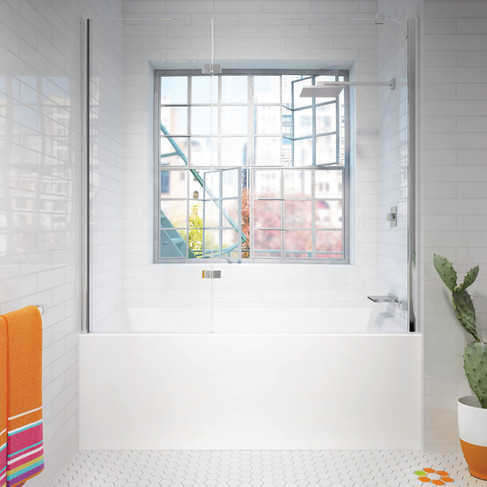5 Common Mistakes to Avoid When Using CGI For Kitchen & Bath Scenes
- Ryan Newfell
- 3 days ago
- 4 min read

CGI is one of the most powerful tools manufacturers have today. It allows complete control over styling, lighting, materials, and environment, often with more flexibility (and lower cost) than traditional photography.
But with that freedom comes risk. Poorly directed or poorly executed CGI can hurt a product’s presentation just as quickly as good CGI can elevate it.
Below are five of the most common mistakes we see manufacturers make when producing CGI lifestyle imagery and how to avoid them so your visuals feel inspiring, believable, and ready to sell.
1. Unrealistic Scenes

Aspirational environments can be beautiful, but they must still feel believable. When a bathroom is placed in a setting no homeowner would ever experience, the viewer’s attention shifts away from the product and toward the strangeness of the space.
The goal of lifestyle CGI is to help customers imagine the product in a real home. If the environment is too imaginative or architecturally improbable, it loses its sales power.
Aspirational does not have to mean unrealistic. Thoughtful materials, natural lighting, and spatial layouts rooted in real design principles go much further than spectacle.
I write about this more in my blog 10 CGI Room Design Principles That Help Your Products Sell.
2. Distracting Backgrounds

When every surface competes for attention, the product becomes secondary. Bold tile patterns behind bold vanities, busy wallpaper behind textured products, dramatic foliage pressed right against the glass - these all create visual noise that dilutes the focus. While a real bathroom is designed to be cohesive and not give any specific area the spotlight, our bathrooms must be designed to showcase a specific product or suite of products.

The background should support the product, not overshadow it. Clean lines, restrained patterns, and controlled contrast will make the fixture feel purposeful and well integrated. Even simple decisions, such as avoiding vertical flutes behind a fluted product, help ensure the viewer’s eye lands where it should.
The most effective lifestyle imagery knows how to guide attention without distraction.
I walk through how to use design, composition, and visual communication fundamentals to design an effective room that sells in Case Study: Designing a Scene That Sells for Woodpro Cabinetry.
3. Crammed Spaces & Products That Don’t Fit

One of the advantages of CGI is that you’re not limited by the constraints of a physical room, but that freedom shouldn’t lead to unrealistic proportions. A double vanity squeezed into a space that barely accommodates it, a tall linen cabinet blocking the flow of a room, or fixtures sharing a wall that would never be built that way all create subtle unease for the viewer.
Manufacturers often want to showcase as many SKUs as possible in a single render, but when the layout feels cramped or spatially inaccurate, the product suffers.
A well-designed CGI scene respects real-world measurements, clearances, and usability. The product should feel naturally at home - not forced into a corner.
Want to know how to effectively plan for your next product launch without cramming everything into one room? Check out my post 5 Essential Tips for Planning Your Product Launch Visuals.
4. Moody & Unnatural Lighting

Lighting can make or break a CGI image. Dramatic scenes, harsh spotlights, or overly theatrical glows may look interesting at first glance, but they rarely feel realistic. Unless the lighting directly supports the product story - such as showcasing a backlit mirror or warm evening tones, it should mimic the type of light the product would actually exist in.

Unnatural shadows, inconsistent light sources, or heavy color casting can quickly signal “CGI” in a way that breaks immersion. The best lighting is intentional, controlled, and consistent with the environment being portrayed.
Realistic lighting doesn’t mean flat - it means thoughtful.
You don't need big budgets or dramatic scenes to compete with the big brands. You can learn more in my post How CGI Helps Boutique Brands Compete with Industry Giants.
5. Low Quality & "Uncanny Valley" CGI
Even a perfectly styled scene can fall apart if the technical execution isn’t strong. Poor material textures, inaccurate reflections, odd geometry, missing shadows, overly smooth surfaces, or plastic-looking finishes all create a negative emotional response reminiscent of the uncanny valley - the feeling that something is “off,” even if the viewer can’t articulate why.
When this happens, the product’s perceived quality suffers as well.
High-end brands need high-end CGI. Proper material mapping, realistic roughness and gloss levels, physically accurate lighting, and correct product scale are non-negotiable. The viewer shouldn’t be thinking about whether the image is CGI - they should simply be appreciating the product.
And if this raises the question, “Is CGI even the right choice?” Absolutely. When executed well, CGI outperforms traditional photography in flexibility, consistency, speed, and cost efficiency. I break down exactly why in CGI vs. Traditional Photography: Why More Brands Are Making the Switch.
Conclusion
The best CGI works because you don’t notice the CGI at all.
You notice the product. You feel the room. You understand the design story instantly.
For manufacturers, these visuals aren’t just pretty pictures, they’re sales tools, brand assets, and the first impression many customers have of your product line.
If you’re investing in imagery, it should work hard for you.
If you’d like guidance on elevating your CGI or want to explore custom lifestyle scenes built with strategy and intention, we would be happy to help.



